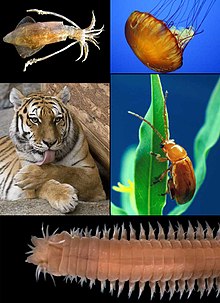ParaHoxozoa
| ParaHoxozoa | |
|---|---|

| |
| Diversity of parahoxozoans | |
| Scientific classification | |
| Domain: | Eukaryota |
| Kingdom: | Animalia |
| Subkingdom: | Eumetazoa |
| Clade: | ParaHoxozoa Ryan et al., 2010 |
| Taxa | |
ParaHoxozoa (or Parahoxozoa) is a
Phylogeny
The tree below, which is congruent with the vast majority of these phylogenomic studies, conveys this uncertainty with a polytomy.
| Choanozoa |
| |||||||||||||||
| |
ParaHoxozoa or Parahoxozoa
Though "ParaHox" genes are usually referred to in
Characteristics
Parahoxozoa was defined by the presence of several gene (sub)classes (HNF, CUT, PROS, ZF, CERS, K50, S50-PRD), as well as
Planula-acoel, triploblasty, and bilaterian similarities
This section may require cleanup to meet Wikipedia's quality standards. The specific problem is: Lots of disconnected sentences, no clear structure. (March 2024) |
The original Bilateria are hypothesized to be a bottom dwelling worm with a single body opening.[16] A through-gut may already have developed with the Ctenophora however.[17] The through-gut may have developed from the corners of a single opening with lips fusing. E.g. Acoela resemble the planula larvae of some Cnidaria, which exhibit some bilaterian symmetry. They are vermiform, just as the cnidarian Buddenbrockia is.[18][19][20] Placozoans have been noted to resemble planula.[21] Usually, "Planulozoa" refers to a Cnidaria–Bilateria clade to the exclusion of Placozoa, but not necessarily.[11] In the other case, when including all three lineages, it appears synonymous with Parahoxozoa.[22] Triploblasty developed before the Cnidaria–Bilateria radiation as well.[23]
ParaHoxozoa/Parahoxozoa taxonomy
The Parahoxozoa has 3 different types of phyla that includes
Placozoans
These are placozoans (e.g.
Cnidarians
Cnidarians (e.g.
Bilaterians
Many species of bilterians (e.g.
,References
- PMID 20920347.
- PMID 20378579.
- PMID 29199080.
- S2CID 4560353.
- PMID 25902535.
- PMID 26596625.
- PMID 28993654.
- PMID 24847885.
- PMID 24337300.
- PMID 31879283.
- ^ ISBN 978-0-691-19706-7.
- S2CID 205241127.
- S2CID 18994676.
- PMID 30859199.
- ISSN 1463-6409.
- S2CID 205247296.
- PMID 27568594.
- S2CID 5170702.
- PMID 18192186.
- PMID 28974637.
- S2CID 16870420.
- S2CID 86185156.
- PMID 21669750.




